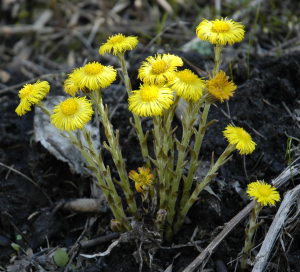
Botanical Name: Tussilago farfara
Common name: Coltsfoot (Hoffmann, 2003, p. 590)
Family: Asteraceae (Hoffmann, 2003, p. 590)
Parts used: Dried flower, leaf (Hoffmann, 2003, p. 590)
Constituents
- Flavonoids: rutin, hyperoside, isoquercetin
- Mucilage
- Inulin
- Pyrrolizidine alkaloids: including senkirkine and tussilagine
- Tannins
(Hoffmann, 2003, p. 590)
Actions
- Anti-inflammatory
- Anticatarrhal
- Antispasmodic
- Antitussive
- Expectorant
- Demulcent
- Diuretic
- Immunostimulant
(Heinrich et al., 2010, p. 235; Hoffmann, 2003, p. 590)
Indications
- Irritating or spasmodic coughs
- Whooping cough
- Bronchitis
- Laryngitis
- Asthma
(Heinrich et al., 2010, p. 235; Hoffmann, 2003, p. 590)
Preparation & Dosage
- Fresh boiled leaves can be applied to boils, abscesses and suppurating ulcers
- Tincture: (1:5 in 40%) 2-4mL/tds
- Infusion: 1-2tsp dried herb/1 cup water/tds
(Hoffmann, 2003, p. 590)
Cautions & Contradictions
- The pyrrolizidine alkaloids have shown hepatotoxic activity in rats, fed daily in high doses, however appear not to cause damage in human chromosomes in vitro (Heinrich et al., 2010, p. 235).
- Not recommended for long periods of time (Hoffmann, 2003, p. 590).
Combinations
For coughs, Coltsfoot is often combines with White Horehound and Mullein (Hoffmann, 1990, p. 192)
REFERENCE
Hoffmann, D. (2003). Medical Herbalism: The Science and Practice of Herbal Medicine. Rochester Vermont: Healing Arts Press.
Heinrich, M., Barnes, J., Gibbons, S., & Williamson, E. (2012). Fundamentals of Pharmacognosy and Phytotherapy (2nd ed.). Edinburgh: Churchill Livingstone/Elsevier.
Image: Lenes, K. (2007). File:Tussilago farfara whole.png. Retrieved from: http://commons.wikimedia.org/wiki/File:Tussilago_farfara_whole.png